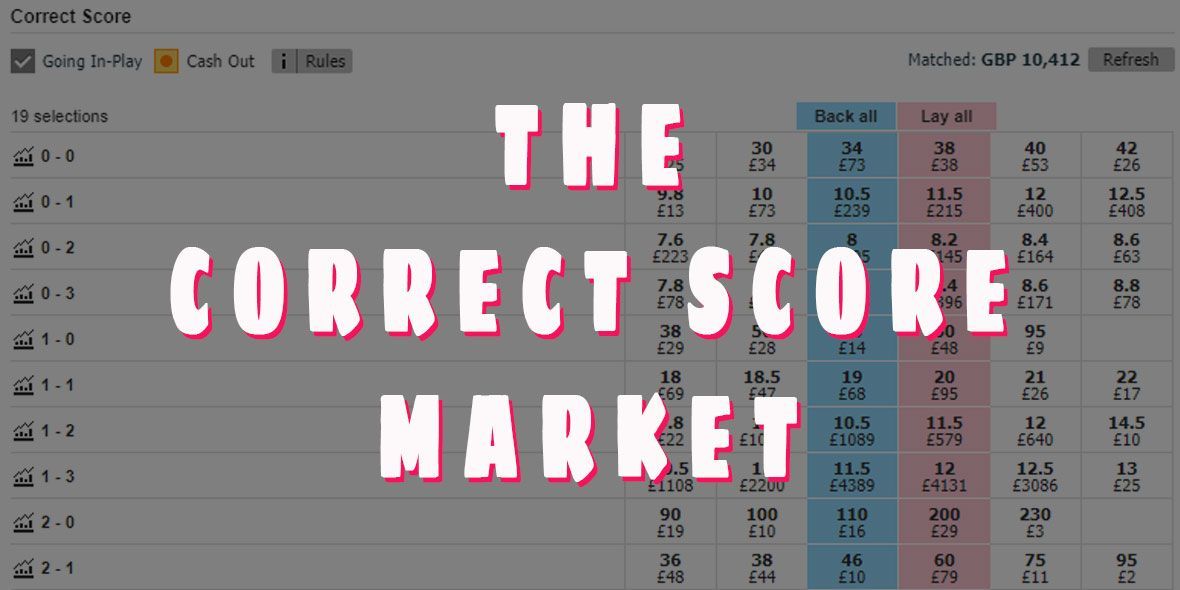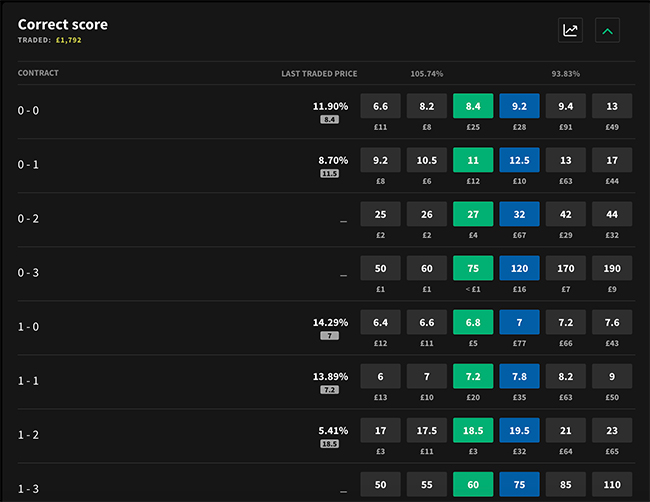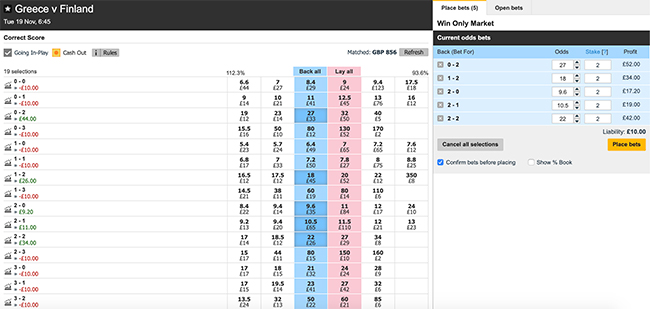How To Find Value In The Correct Score Market

If you have recently started trading on Betfair, you may have noticed one of the most liquid football markets is for correct score betting.
In this guide, we will look at how to trade the correct score, the advantages and disadvantages of trading the correct score market, and a few different techniques you can try out for yourself.
What Is Correct Score Betting?
Football correct score betting at its simplest is as easy as it sounds. You are basically placing a wager on what you think the score of a match will be, whether it is 0-0 or 5-0 or any number you pluck out of your head.
The market closes at the end of 90 minutes plus stoppage time and does not include extra time or penalties.
We recommend using Betfair for correct score trading, as it tends to have the most liquid markets compared to other exchanges.
There are other exchanges you can use, and Smarkets also tends to have fairly good liquidity in the correct score market.


Here we have the correct score market for Greece v Finland, on both Betfair and Smarkets. More money has been traded on Smarkets, but it is still 24 hours before kick-off.
Correct score betting is tempting as the odds may seem quite high, considering that almost 80% of Premier League matches have 3 goals or less.
This gives only 10 different possible outcomes (0-0,1-0, 0-1, 1-1, 2-0, 0-2, 2-1, 1-2, 3-0, 0-3). However, picking which one of those outcomes will occur can be tricky.
We will be looking at the correct score market in terms of trading.
The difference between regular punting and trading is that when you are trading, you will always lock in a profit as soon as possible rather than greed out and hope you get lucky.
What Stats Should I Look At?
There are a few stats you can look up before a match to determine if the match is worth trading the correct score.
Generally, traders are either looking for a match that will be high-scoring or a match that will be low-scoring.
When looking for low-scoring matches, traders will look at the match odds, which should be close (indicating it will be a tight game), and the recent history of both clubs and the outcomes of previous matches.
High-scoring matches can happen when one side is heavily favoured. However, it is important to look at the underdog team in this situation. If they are known for ‘parking the bus’, then even though they are not likely to win, the score margin may still be fairly small.
High-scoring matches can occur when two teams that play open, expansive and attacking football meet. Be sure to check the teams when they are announced before the start of the match.
If both teams put out a defensive line-up, the chances of a low-scoring match increase. This will be reflected in the odds shifting on Betfair as the teams are announced.
Correct Score Trading Strategies
Trading is all about decreasing your risk as much as possible. Correct score trading is never risk-free (unless you are playing with free bets) but there are ways you can decrease your risk substantially.
High-Scoring Example
For both high-scoring and low-scoring correct score trading, you will want to spread your risk to cover a number of outcomes.
Instead of just selecting one scoreline, you might select four or five potential outcomes.
Let’s say we think the upcoming Greece v Finland match will be a fairly high-scoring match, but we are not sure which side will come out on top.
We can spread our risk by betting on a few different outcomes. In this example, we have bet £2 on 2-0, 0-2, 1-2, 2-1 and 2-2, making our total liability £10.00, and our potential profit varies from £17.20 up to £52.00.

This is still technically punting, even though we have decreased our risk by spreading it amongst several outcomes.
In order to decrease our risk further, we can continue to bet in-play.
We have bet on high scores for this match. This means that if there are a couple of goals early on, we can exit out of our position and still make a profit.
The more goals that go in, the shorter the odds get for our higher correct scores. This means we can sell for a higher price than we bought at, making us a profit.
Low-Scoring Example
It is also possible to do this with matches where we think the score will be low. If the match market is close and both teams are defensively minded, we can select a range of scores that reflect our prediction.

Here, we have selected a few outcomes that would be likely in an evenly-matched, low-scoring game. Our total liability is £6.00, and our potential profit ranges from £10.80 to £20.00.
However, as before, this is still technically just punting even though we are reducing our risk by spreading it out over a few different outcomes.
If things go in our favour, we can trade our position to come out with a profit even if the outcome of the match differs from our predictions.
If the match progresses to the second half without either side scoring, the odds for our selected outcomes will most likely shorten. This means we can trade out of our position for a profit, regardless of what the final outcome is.
Likewise, if there is a goal early on which results in one of the teams adopting a more attacking approach, it would be sensible to exit out of our wager to try and minimise our losses.
What Are The Advantages Of Trading?
If you are looking to make long-term profits, trading is always the most sensible option.
We can ‘hedge’ our bets. If the match is going in our favour and looks likely to end in a result we have bet on, we can secure our position for a guaranteed profit by laying our bet to cover all outcomes.
This decreases the amount of profit we will make, but it also guarantees that profit. For a trader, this is always the most favourable option.
Remember that football is an unpredictable game with goals often being scored in the final third of the match. It is always more sensible to take the guaranteed profit and move on to the next match.
About the Author
This post was written by Andy Beggs. Andy is a keen sports fan and has been writing for Beating Betting from his home in Australia since August 2019.
